Home | Category: The Torah / The Old Testament
WHO WROTE THE BIBLE

face of God as he produces the Moon and Sun
Many, but by no means all, Jews believe that Moses was the author of the Torah, which contains the account of creation and the earliest days of Judaism. Many Christians have similar views. Biblical scholars, however, came to the conclusion that the authorship of the book is unknown. Even many Jews accept that the Torah and larger Hebrew Bible were the work of many authors, written down, compiled, and edited by others. For centuries, the oldest manuscripts of the Hebrew Bible were dated to the A.D. 9th century. Then, in 1947, the Dead Sea Scrolls, which contain books of the Hebrew Bible, were discovered in a cave near Qumran, Israel, northwest of the Dead Sea. These scrolls were hidden by clerics (priests), probably Essenes, to protect them from the invading Romans. With the discovery of the Dead Sea Scrolls, the earliest known surviving manuscript versions of the Hebrew Bible date from the first century B.C.. [Source: Encyclopedia.com]
Matti Friedman of Associated Press wrote: “For millions of Jews and Christians, it's a tenet of their faith that God is the author of the core text of the Hebrew Bible _ the Torah, also known as the Pentateuch or the Five Books of Moses. But since the advent of modern biblical scholarship, academic researchers have believed the text was written by a number of different authors whose work could be identified by seemingly different ideological agendas and linguistic styles and the different names they used for God. [Source: Matti Friedman, Associated Press, June 30 2011]
“Today, scholars generally split the text into two main strands. One is believed to have been written by a figure or group known as the "priestly" author, because of apparent connections to the temple priests in Jerusalem. The rest is "non-priestly." Scholars have meticulously gone over the text to ascertain which parts belong to which strand.
“Over the past decade, computer programs have increasingly been assisting Bible scholars in searching and comparing texts, but the novelty of the new software seems to be in its ability to take criteria developed by scholars and apply them through a technological tool more powerful in many respects than the human mind, Segal said.
Websites and Resources: Bible and Biblical History: Bible Gateway and the New International Version (NIV) of The Bible biblegateway.com ; King James Version of the Bible gutenberg.org/ebooks ; Bible History Online bible-history.com ; Biblical Archaeology Society biblicalarchaeology.org ; Judaism Virtual Jewish Library jewishvirtuallibrary.org/index ; Judaism101 jewfaq.org ; torah.org torah.org ; Chabad,org chabad.org/library/bible ; BBC - Religion: Judaism bbc.co.uk/religion/religions/judaism ; Internet Jewish History Sourcebook sourcebooks.fordham.edu Christianity: BBC on Christianity bbc.co.uk/religion/religions/christianity ; Christian Classics Ethereal Library www.ccel.org ; Sacred Texts website sacred-texts.com ; Internet Ancient History Sourcebook: Christian Origins sourcebooks.fordham.edu
RECOMMENDED BOOKS:
“Who Wrote the Bible?” by Richard Friedman, Julian Smith, et al.
Amazon.com ;
“The Torah: The Five Books of Moses, the New Translation” by the Jewish Publication Society Inc. (Editor) Amazon.com ;
“Commentary on the Torah” by Richard Elliott Friedman Amazon.com ;
“The Torah: A Modern Commentary” by Gunther Plaut Amazon.com ;
“JPS Hebrew-English TANAKH” (Hebrew Bible) by Jewish Publication Society Inc. Amazon.com ;
“The Hebrew Bible: A Translation with Commentary” (audiobook) by Robert Alter, Edoardo Ballerini, et al. Amazon.com ;
“The Holy Bible in English easy to read version” Amazon.com ;
“A History of the Bible: The Story of the World's Most Influential Book”
by John Barton, Ralph Lister, et al. Amazon.com ;
“The Complete Guide to the Bible” by Stephen M. Miller Amazon.com ;
“The Talmud” by H Polano and Reverend Paul Tice Amazon.com ;
“Everyman's Talmud: The Major Teachings of the Rabbinic Sages” by Abraham Cohen
Amazon.com
Did Moses Write the Early Books of the Bible
Gerald Larue wrote: The Old Testament writings "which begin with the creation of the world and trace the development of the Hebrew people through the patriarchal period up to the invasion of Canaan, were believed from very early times to be the work of one person — Moses. There were those who questioned the Mosaic authorship. About A.D. 500 a Jewish scholar wrote in the Talmud that the last eight verses of Deuteronomy which tell of Moses' death must have been written by Joshua. By the time of the Protestant Reformation, Roman Catholic and Protestant scholars were discussing the difficulty of maintaining the Mosaic authorship of the Torah. [Source: Gerald A. Larue, “Old Testament Life and Literature,” 1968, infidels.org ]
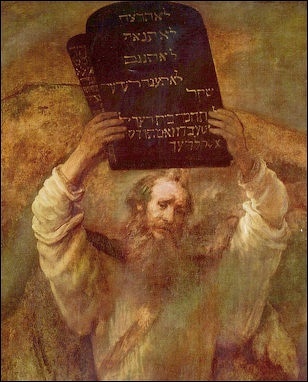
Moses with the Commandments of God
“Part of the problem lies in the fact that at no point in the Pentateuch is it stipulated that Moses is the author; certain portions are said to be by Moses, but not the total writing. On the other hand, there is good evidence that Moses could not have been the author. In Gen. 14:14, Abram is said to have led a group of men to the city of Dan, but elsewhere it is stated that this city did not come into existence until the time of the Judges (Judg. 18:29), long after Moses' time. The conquest by the Gileadites of the area called Havvothjair took place in the time of the Judges (Judg. 10:3-4), yet it is reported in the Pentateuch (Num. 32:41; Dent. 3:14). The time of the Hebrew monarchy is reflected in Gen. 36:31, yet this passage is set in a discussion of the patriarchal period. How could Moses write of conditions that did not come into being until long after his death?
“There is some indication that whoever wrote certain parts of the Pentateuch was in Palestine, within the territory which in Moses' time had not yet been entered. Gen. 50:10, Num. 35:14, and Deut. 1:1, 5, 3:8, 4:46 speak of places which are located "beyond the Jordan," which is to say on the east side of the Jordan and outside of Palestine proper. Such a statement could only be uttered by someone on the western side of the Jordan river, and Moses, we are told in Deut. 34, never entered that land.
“Other evidence also suggests that Moses did not write the Pentateuch, and that many different writers made contributions to it. There are contradictory statements, one of the most obvious of which concerns the number of animals Noah took into the ark. In Gen. 6:19 Noah is told to take two of every kind of living creature — one male and one female — but in Gen. 7:2 seven pair of clean animals and birds are required. Would a single writer be so inconsistent?
“Num. 35:6-7 specifies that Levites were to receive certain territorial inheritances, but Deut. 18:1 makes it quite clear that they are to have no inheritance. According to Exod. 3:13-15 and Exod. 6:2-3, the personal name of God, "Yahweh,"5 was revealed for the first time to Moses on the holy mountain. Prior to this revelation, Yahweh was known only as "Elohim,"6 or as "El Shaddai."7 On the other hand, however, Gen. 4:26 indicates that from very early times men called upon God by his personal name of Yahweh, and in numerous places the patriarchs use the name Yahweh (see Gen. 22:14, 26:25, 27:20, 28:13). Would a single author make statements so contradictory? In fact, the very manner in which divine names are used prior to the revelation of Yahweh's name in Exodus raises problems. In certain sections of Genesis "Elohim" appears exclusively (Gen. 1:1-31, 9:1-11) ; in other places "Yahweh" appears alone (Gen. 4:1-16, 11:1-9). It would appear that different traditions have been brought together.
“Some stories appear more than once, in what scholars have called "doublets." For example, in Gen. 15:5 Abraham is promised many descendants, and in Gen. 17:2 the promise is needlessly repeated. In Gen. 12:11-20 Sarah pretends to be the sister of Abraham. This same story appears in a slightly different setting in Gen. 20:1-18, and is told again with Isaac and Rebekah as central actors in Gen. 26:6-11. In the last two examples, Philistine kings are mentioned and the Philistines did not settle in Palestine until the twelfth century. How are such repetitions, contradictions and anachronisms best explained?
Analysis of Who Wrote the First Parts of the Bible
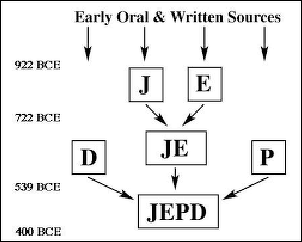
Writers of the Bible: J, E, P and D?
Larue wrote: “By the seventeenth century a number of scholars had wrestled with the problems of the Mosaic authorship of the Pentateuch. Carlstadt, a leader of the Reformation movement in Germany, wrote a pamphlet in 1520 arguing that Moses did not write the Pentateuch, for the style of writing in the verses reporting Moses' death (Deut. 32:5-12) was that of the preceding verses. In 1574, A. Du Maes, a Roman Catholic scholar, suggested that the Pentateuch was composed by Ezra, who used old manuscripts as a basis. Thomas Hobbes, the English philosopher, concluded in 1651 that Moses wrote only parts of Deuteronomy (Leviathan III:33). In Tractatus theologico-politicus (1677), Baruch Spinoza, the Jewish philosopher, recognized as one of the founders of modern biblical criticism, reached a conclusion much like that of Du Maes, that Ezra compiled Genesis to II Kings from documents of varying dates. Shortly afterward, Richard Simon, a Roman Catholic priest, often called "the father of biblical criticism," gathered together the substance of critical analyses up to his time and raised the problem of literary history, thus opening the door to the application of techniques used in the study of non-sacred literature to the Bible. [Source: Gerald A. Larue, “Old Testament Life and Literature,” 1968, infidels.org]
“In the eighteenth century Jean Astruc, a celebrated physician, published a treatise on Genesis in which he postulated that Moses used two major sources in writing the book of Genesis.8 The source in which the name "Elohim" is used for God, Astruc called "A," and that which used "Yahweh" was labeled "B." Ten fragmentary sources were also recognized and given alphabetical designations. Additional criteria for defining sources were worked out by J. G. Eichorn, sometimes called "the father of Old Testament criticism" or, on the basis of his five volume "Introduction" to the Old Testament, "the father of the modern science of introductory studies."
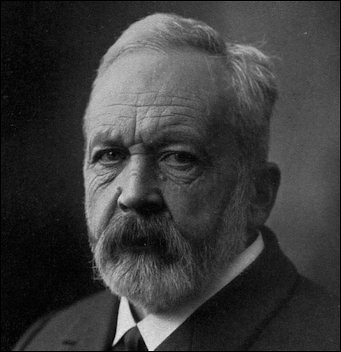
Julius Welhausen
“Others built upon these foundations. In 1806-7 W. M. L. DeWette, a German scholar, published a two volume introductory study of the Old Testament in which he suggested that the book found in the temple in 621 B.C., during the reign of King Josiah of Judah (II Kings 22-23), was the book of Deuteronomy. In the work of Julius Wellhausen, who built upon the research of K. H. Graf and Wilhelm Vatke, the most significant analysis of the Pentateuch was made.The thesis known as the Graf-Wellhausen theory, or as the Documentary Hypothesis, still provides the basis upon which more recent hypotheses are founded.
“The Graf-Wellhausen analysis identified four major literary sources in the Pentateuch, each with its own characteristic style and vocabulary. These were labeled: J, E, D and P. The J source used the name "Yahweh" ("Jahveh" in German) for God, called the mountain of God "Sinai," and the pre-Israelite inhabitants of Palestine "Canaanites," and was written in a vivid, concrete, colorful style. God is portrayed anthropomorphically, creating after the fashion of a potter, walking in the garden, wrestling with Jacob. J related how promises made to the patriarchs were fulfilled, how God miraculously intervened to save the righteous, or to deliver Israel, and acted in history to bring into being the nation.11 E used "Elohim" to designate God until the name "Yahweh" was revealed in Exod. 3:15, used "Horeb" as the name of the holy mountain, "Amorite" for the pre-Hebrew inhabitants of the land, and was written in language generally considered to be less colorful and vivid than J's. E's material begins in Gen. 15 with Abraham, and displays a marked tendency to avoid the strong anthropomorphic descriptions of deity found in J. Wellhausen considered J to be earlier than E because it appeared to contain the more primitive elements.
“The Deuteronomic source, D, is confined largely to the book of Deuteronomy in the Pentateuch, contains very little narrative, and is made up, for the most part, of Moses' farewell speeches to his people. A hortatory and emphatic effect is produced by the repetition of certain phrases: "be careful to do" (5:1, 6:3, 6:25, 8:1), "a mighty hand and an outstretched arm" (5:15, 7:19, 11:2), "that your days may be prolonged" (5:16, 6:2, 25:15). Graf had demonstrated that knowledge of both J and E were presupposed in D, and having accepted DeWette's date of 621 B.C. for D, argued that J and E must be earlier. J was dated about 850 B.C. and E about 750 B.C.
“The Priestly tradition, P, reveals interest and concern in whatever pertains to worship. Not only does P employ a distinctive Hebrew vocabulary but, influenced by a desire to categorize and systematize material, develops a precise, and at times a somewhat labored or pedantic, style. Love of detail, use of repetition, listing of tribes and genealogical tables, does not prevent the P material from presenting a vivid and dramatic account of Aaron's action when an Israelite attempted to marry a Midianite woman (Num. 25:6-9) or from developing a rather euphonious and rhythmical statement of creation (Gen. 1). The Graf-Wellhausen hypothesis noted that P contained laws and attitudes not discernible in J, E, or D and reflected late development. P was dated around the time of Ezra, or about 450 B.C.
“The combining of the various sources was believed to be the work of redactors. Rje, the editor who united J and E around 650 B.C. provided connecting links to harmonize the materials where essential. Rd added the Deuteronomic writings to the combined JE materials about 550 B.C., forming what might be termed a J-E-D document. P was added about 450-400 B.C. by Rp, completing the Torah. This hypothesis,12 by which the contradictions, doublets, style variations, and vocabulary differences in the Pentateuch were explained, can best be represented by a straight line.
“Variations in the Graf-Wellhausen theory have been proposed since it was first expounded in the nineteenth century. Research into the composition of the individual documents produced subdivisions such as J1, J2, J3, etc. for J, and El, E2, and so on, for E until the documents were almost disintegrated by analysis.13 New major sources were recognized by other scholars. Professor Otto Eissfeldt discovered a fifth source beginning with Gen. 2 and continuing into Judges and Samuel which he labeled "L" for "Lay" source.14 R. H. Pfeiffer of Harvard University identified an "S" source in Genesis, so labeled because Pfeiffer believed it came from Seir (in Edom) or from the south.15 The great Jewish scholar, Julian Morgenstern, singled out what he believed to be the oldest document, "K," which, while in fragmentary form, preserved a tradition of Moses' relationships with the Kenites.16 Martin Noth of Germany argued for a common basic source "G" (Grundlage for "ground-layer" or "foundation") upon which both J and E are developed.17
Different Approaches to Unraveling the Early of Who Wrote the Pentateuch?
Larue wrote: “Other patterns of approach to biblical literature have been developed and most of these supplement the historical-literary method. Each new methodology causes the scholar to reconsider familiar material in the light of new evidence or from a different angle of vision. The results of the multiple approach have been new insights into and a clearer understanding of biblical life and literature and a diminishing dogmatism about what any individual or group of scholars might consider to be "firmly established conclusions." [Source: Gerald A. Larue, “Old Testament Life and Literature,” 1968, infidels.org ]
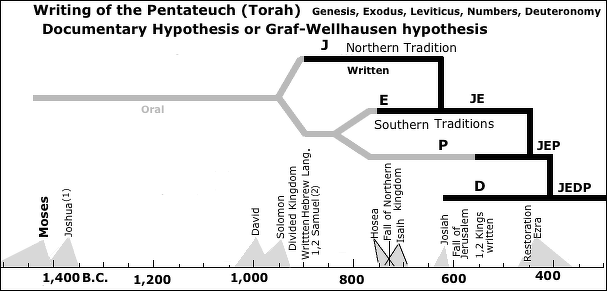
“Deuteronomic History: A somewhat different study arrangement of part of the Pentateuch has been proposed by Martin Noth.1 Deuteronomy is combined with Joshua, Judges, I and II Samuel, and I and II Kings as part of an immense Deuteronomic history extending from Moses to the destruction of Judah by the Babylonians in the sixth century. The work, Noth believes, was composed by an individual who skillfully blended a variety of source materials into a single work. The point of view is Judaean, and the interpretive key to the whole is found in Deut. 4:44-30:20. The book of Deuteronomy is, according to this analysis, to be studied as part of an historical collection rather than simply as part of the Pentateuch. Noth's thesis will be acknowledged in this book.
“Cultic Interpretation: A different approach, stressing the use of the Old Testament in worship, provides important clues for understanding the literature.2 Just as myth can be interpreted as the spoken or recited portion of a ritual, and drama or sacrifice or other physical performance as the enactment of the myth, the cult may be recognized as the structure of the organization making possible the ritual performance. Within organized religious structure, within the cult, the traditions of the past were transformed into ritual acts; therefore, to understand the significance of the tradition one must understand its relationship to the cult. Large portions of the Old Testament lend themselves to this mode of analysis.
“Three great annual festivals were observed in ancient Israel: the Feast of Unleavened Bread (Passover)4 in the spring, the Feast of Weeks (or Harvest or Pentecost) in the early summer, and the Feast of Ingathering (Booths) in the fall (Exod. 23:14-17, 34:18-23). The Unleavened Bread celebration appears to have combined a nomadic pastoral festival when a lamb was sacrificed (celebrated on the first day of the festival) and an agricultural feast of unleavened bread occupying seven days, perhaps borrowed from the pre-Hebrew Canaanite inhabitants of Palestine. The Feast of Weeks, an agricultural harvest celebration, included the offering of "firstfruits" through which the total harvest, represented in the first reaping, was symbolically presented to the deity. During the festival of Booths, celebrated at harvest, the people lived in huts made of boughs, much as some families in the Near East do today at harvest time. Unleavened Bread was associated with the escape of the Hebrews from Egypt, Booths with the wilderness wanderings, and Weeks, ultimately, with the giving of the Torah, or with Noah's covenant.7 In addition to these major observances, numerous other cultic rites may have taken place at local shrines.8
“Participation in the cult ceremonies had individual and national significance. For the individual, when the ritual was successfully completed, it marked the achievement of harmonious relationships with life-giving powers and with all life within the locale, the attainment of personal communion with the deity, and the participation in rites of community re-invigoration.9 For the nation the rite marked the renewal of life-power and of divine human relationships, and symbolized divine blessing for those belonging to the cult. What had happened in the past had meaning for the present; deliverance in the past, successfully re-enacted, was related to blessing, forgiveness, favor and deliverance in the present.
“Such an approach to Old Testament literature tends to give scant attention to the analysis of sources. Emphasis is placed on blocks of literature and the usage of these literary units in cult rites. For example, it is argued that the annual festival of Weeks, celebrated at Gilgal, dramatized the deliverance of Israel from Egypt and the crossing of the Sea.10 Chapters 1-5 of Joshua are based upon this ritual and clearly demonstrate that the miraculous passage through the waters was enacted by a procession through the Jordan River. This kind of approach renders the attempt to distinguish the sources of Josh. 1-5 relatively unimportant.11
“Form Criticism: Form criticism, or "form history," is a method of literary analysis seeking to go behind the written documents to the underlying oral traditions. Certain presuppositions, drawn from the study of folk literature, are basic to the method. It is assumed that folk memory tends to operate with small units, often no more than a line or two. These units grow out of folk events, and each unit has a characteristic pattern associated with the event, whether it be a wedding, a birth celebration, a funeral, a celebration of a victory over an enemy, or a liturgy accompanying an act of worship. Each unit, coming out of its own particular life setting,17 tends to have its structure or form fairly well fixed insofar as structural pattern, length and tendency18 are concerned. That is to say, the form associated with a wedding would differ from that utilized for funeral situations. Custom determined what details were "proper" or "right" for each. So long as the community interest in the event commemorated is kept alive, the oral unit will survive.
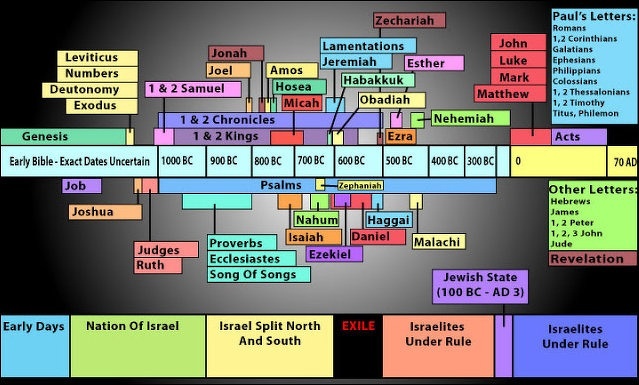
Bible Development Timeline
“Within the Old Testament, certain features suggest the validity of such an approach: the priests gave instruction, the prophets uttered oracles, the wise men spoke their aphorisms, the judges pronounced verdicts, the choristers sang their psalms. For each situation there was a proper pattern of utterance. As we shall see, analysis of the cultic use of the Psalms depends heavily upon the recognition of poetic forms associated with specific situations. It is the purpose of form criticism to recognize stylistic features, to analyze them in terms of life settings and tendencies, and to trace the history of the form or the way in which its use developed within biblical literature.
“The significance of this study for understanding oral tradition is obvious, for it aids in understanding how the literature could be preserved through the patriarchal period and even through the time of the Babylonian Exile. It is also significant for literary criticism, for not only does it draw attention to the important pre-literary stage of biblical materials, but it provides the basis for better understanding of the significance of Hebrew-Jewish literary patterns.
Using Oral Traditions to Study the Bible
Larue wrote: “A number of Scandinavian scholars have moved away from the patterns of literary analysis previously discussed and have laid stress upon the importance of oral tradition in the transmission of Old Testament materials.12 One scholar, Eduard Nielsen, has argued that written Old Testament records prior to the Exile (sixth century) were negligible. This thesis rests upon a number of presuppositions. It is assumed that prior to the Exile writing skills were confined to a group of specialists whose services were employed primarily in formulating business contracts, legal texts, and inscriptions on monuments. Cult legends, traditions and laws were transmitted orally. For example, Isa. 8:16 records the prophet's intent to "bind up" his words with his disciples, and it is assumed that the "binding" is in their memory. When Jeremiah's words were written down because he could not deliver them in person and the scroll was destroyed by the king, Jeremiah seemed to have no trouble in reiterating his message, apparently in the same words (Jer. 36). Because there was no real dependency upon the written record, memory was cultivated and could be relied upon. [Source: Gerald A. Larue, “Old Testament Life and Literature,” 1968, infidels.org ]
“Where traditions were recited before a group, certain controls were placed upon the reciter, tending to "freeze" the form of the narrative and guarantee accuracy: controls from the professional body of which he was a part, and controls from listeners familiar with the tradition. Stereotyped forms tend to aid in memorization, and oral tradition may thus become as fixed as written records.
“Certain criteria help to distinguish oral forms. For example, where only a single written prose record exists, the following clues point to an oral tradition back of the written form: a monotonous and rhythmic style, the repetition of expressions, changes of style in a single sentence which would ordinarily be caught and remedied in a written work, and use of catch words and other mnemonic devices. When there are doublets with discrepancies, one must undertake the difficult task of determining the relationship of the accounts to each other and to the earlier oral or written traditions.13
“It is further presupposed that any written traditions that may have existed probably were not carried to Babylon by the Exiles; thus the whole pre-Exilic tradition, fortunately committed to memory, was perpetuated through oral tradition. Only after the destruction of Jerusalem was it finally reduced to writing.14 Such a thesis does not deny that traditions from different sources were ultimately blended, but it does reduce to unimportance the results of source analysis.
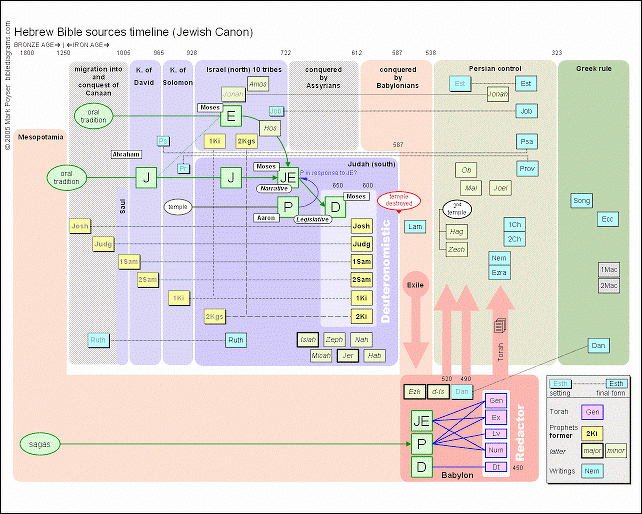
Another Bible Development Timeline
“Up to the present time there has been no widespread acceptance by scholars of this particular hypothesis of the oral traditionalists. No one will question that oral forms lie back of the written materials, but few will accept the sixth century B.C. date for the beginning of written records. We will give limited attention to literary forms but we will not attempt to investigate the complicated and demanding subject of the oral traditions that lie back of the written records, except insofar as this study relates to "form criticism." (See below.)
Archaeological and Linguistic Studies of the Bible
“Archaeological and language studies, special areas of research, have made significant contributions to the understanding of the Bible.
“Archaeological research, concerned with the scientific study of the ancient past, may conveniently be divided into three areas: field work, analysis (some of which will also be done in the field) and application (some of which will also be done in the field). Field work consists of the discovery, excavation and identification of sites. Ancient cities were generally located near adequate water and agricultural resources and on trade routes. For purposes of defense, and perhaps to avoid flood waters, the cities were often built on hilltops. During the hundreds of years that these sites were occupied, they suffered destruction by enemies, earthquake, and fire, only to be rebuilt and reoccupied. As layers or strata of cultural deposit accumulated, the height of the mound or tell19 rose higher and higher. Many tells have been mapped and some have been identified. Often local Arabic names echo ancient biblical designations.20 Sometimes careful descriptions of the location in ancient records, including the Bible, make identification possible. Excavation of ancient sites involves careful removal of cultural layers, accurate cataloging of soil characteristics, artifacts, buildings, walls, etc. Analysis, which begins on the site and is continued after excavation, comprises dating of pottery vessels and sherds or pieces, identification of buildings, and interpretation of all like data significant for understanding the history of the site. Application, which may also begin on the site, is the use of information resulting from the excavation for better understanding of some aspects of the Bible or Near Eastern history and ecology. From archaeological research has come knowledge of nations heretofore unknown (such as the Hittites),21 a staggering amount of linguistic knowledge of Semitic languages including Ugaritic or Canaanite and Akkadian, and also of non-Semitic languages such as Egyptian, Hittite and Sumerian, some of which have helped in providing better translations of the Bible and all of which have made available vast quantities of textual data. In addition, many historical details omitted from the Bible are recovered and, what is perhaps equally important, many historical details provided in the Bible are confirmed.22 In a broader context, the recovery of household items, tools, jewelry, toys, weapons and cultic items, and the uncovering of homes, temples, industrial plants and other facets of daily life have put flesh and bone on biblical personnages, revealing them as individuals with responsibilities, interests and concerns parallel to those of our own time. The fruits of archaeology will be utilized throughout this book.23
“From specialists in language have come translated texts of myths, prayers, hymns, historical documents, wisdom writings and other literature of the great neighboring nations of Palestine. Cuneiform tablets relating beliefs about creation, the flood, gods and goddesses have provided important information for understanding the Bible. Such knowledge makes it possible to comprehend the flow of ideas and the impact of one culture upon another, without ignoring the distinctiveness of each. Biblical literature is best understood in the context of the literature of the ancient Near East, for not only are relationships of concepts recognized, but the distinctiveness of Hebrew-Jewish writings is made clear.
“A further contribution of linguists is in the provision of better texts and translations of the Bible. Some portions of the Bible have suffered in transmission.24 On occasion a word appears only once in the Bible and its meaning is not clear.25 Through comparative linguistics and manuscripts studies, better and clearer Bible texts and translations are available. We will employ the results of such research.
Domesticated Camels Came to Israel in 930 B.C., Centuries Later Than Bible Says

milking a camel
Research published in late 2013 by two Tel Aviv University archaeologists shows that camels weren't domesticated in the eastern Mediterranean until the 10th century B.C.—several centuries after the time they appear in the Bible. The camels appear suddenly, following major changes in copper production throughout the region.
Mairav Zonszein wrote in National Geographic: “While there are conflicting theories about when the Bible was composed, the recent research suggests it was written much later than the events it describes. This supports earlier studies that have challenged the Bible's veracity as a historic document. The study, published in Tel Aviv: Journal of the Institute of Archaeology of Tel Aviv University, concerned the introduction of domesticated camels at copper smelting sites in Israel's Aravah Valley. [Source: Mairav Zonszein, for National Geographic, February 10, 2014 ~]
“The dromedary, or one-humped camel, is mentioned in the Bible 47 times. Stories about the Jewish patriarchs—Abraham, Joseph, and Jacob—include descriptions of camels as domesticated animals. For example, Genesis 24:11 says, "And he made his camels to kneel down without the city by a well of water at the time of the evening, even the time that women go out to draw water." Historians believe these stories took place between 2000 and 1500 B.C., based on clues such as passages from Genesis, archaeological information from the site of the great Sumerian city of Ur (located in modern Iraq), and an archive of clay tablets found at the site of Mari (in modern Syria). ~
“Using radiocarbon dating and evidence unearthed in excavations, Israeli archaeologists Erez Ben-Yosef and Lidar Sapir-Hen have pegged the arrival of domesticated camels in this part of the world—known to scholars as the Levant—to a much later era. They were also able to more precisely pinpoint the time span when that arrival occurred. "By analyzing archaeological evidence from the copper production sites of the Aravah Valley, we were able to estimate the date of this event in terms of decades rather than centuries," Ben-Yosef said in a press release put out by Tel Aviv University last week. The study was able to "narrow down the range in which domesticated camels were introduced to 30 years," said Sapir-Hen, an archaeozoologist who studies the role of animals in ancient human culture, in a phone interview. It's "sometime between 930 and 900 B.C."” ~
Copper, Camels and the Bible
Mairav Zonszein wrote in National Geographic: “The Aravah Valley marks the Israeli-Jordanian border as it runs from the Dead Sea to the Gulf of Aqaba in the Red Sea. This area was a center of copper production beginning as early as the 14th century B.C. and ending in the late 9th century B.C. Archaeologists have identified an interesting pattern in their studies of animal remains from sites in this valley. Large quantities of camel bones appear only in the levels dated from the last third of the 10th century through the 9th century B.C. [Source: Mairav Zonszein, for National Geographic, February 10, 2014 ~]
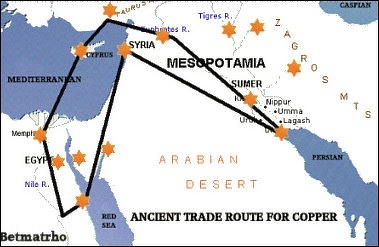
“The camels appear suddenly, following major changes in copper production throughout the region. This period coincides with the invasion of Egyptian king Sheshonq I—known in the Bible as Shishak-in 925 B.C. Archaeologists now wonder if the events are connected. After Egypt conquered the kingdoms of Judah and Israel, it may have reorganized the copper business and introduced camels as a more efficient means of transport than the donkeys and mules used previously. This would have had huge economic and social consequences for the Levant, opening it to parts of the world that lay beyond vast deserts, to which it had never before been connected. ~
“Camels were probably first domesticated in the Arabian Peninsula in the early first millennium B.C. Archaeologists base this date on mortality profiles of excavated skeletons, the gender of the animals, and lesions on leg bones that would have resulted from the repetitive stress of working as pack animals. The Arabian Peninsula borders the Aravah Valley, which would have been a logical gateway for camels into the Levant. In fact, Ben-Yosef and Sapir-Hen believe that the domesticated camels buried at sites in the Aravah Valley may have been among the first such creatures to leave Arabia. Archaeological excavations in the Aravah Valley have turned up bones of camels from earlier periods, perhaps even before the start of the Neolithic (about 9,700 B.C.), but those were probably wild animals that ran free, never burdened with the weight of copper ingots on their back.” ~
Biblical Scholars
There are number of archaeologists at work trying to find archaeological evidence to back up episodes and events in the Bible and the Torah and prove they are historical facts or at least historical probabilities or possibilities. Among the key events they are seeking evidence of are the Israelites escape from Egypt and settlement of Canaan and the rule of David and Solomon. Among the major voices in this field is Israeli archaeologist Adam Zertal, who claims to have found Joshua’s altar on Mount Ebla.
Israel Finkelstein, a respected authority on early Biblical history at Tel Aviv University, is known best for arguing that the events of the Bible are often more indicative of the time they were written, mostly during the reign of the Judean King Josiah (ruled 639 to 609 B.C.) than the time they are supposed to have taken place.
Robert Draper wrote in National Geographic: The once common practice of using the Bible as an archaeological guide has been widely contested as an unscientific case of circular reasoning — and with particular relish by Tel Aviv University's contrarian-in-residence Israel Finkelstein, who has made a career out of merrily demolishing such assumptions. He and other proponents of "low chronology" say that the weight of archaeological evidence in and around Israel suggests that the dates posited by biblical scholars are a century off. The "Solomonic" buildings excavated by biblical archaeologists over the past several decades at Hazor, Gezer, and Megiddo were not constructed in David and Solomon's time, he says, and so must have been built by kings of the ninth-century B.C.'s Omride dynasty, well after David and Solomon's reign. [Source: Robert Draper, National Geographic, December 2010]
Draper said many archaeologists question whether the obsessive scramble to prove the biblical narrative is a healthy enterprise. One of them, Tel Aviv University's Raphael Greenberg, flatly states, "It's bad for archaeology. What we're supposed to contribute is a point of view that isn't available from texts orpreconceived notions of history — an alternative vision of the past: relations between rich and poor, between men and women. Something richer, in other words, than just validating the Bible."
Image Sources: Wikimedia, Commons, Schnorr von Carolsfeld Bible in Bildern, 1860, except Timelines, Relevancy 22, Documentary Theory, Donsnotes Text Sources: Internet Jewish History Sourcebook sourcebooks.fordham.edu “World Religions” edited by Geoffrey Parrinder (Facts on File Publications, New York); “ Encyclopedia of the World’s Religions” edited by R.C. Zaehner (Barnes & Noble Books, 1959); “Old Testament Life and Literature” by Gerald A. Larue, New International Version (NIV) of The Bible, biblegateway.com; Wikipedia, National Geographic, BBC, New York Times, Washington Post, Los Angeles Times, Smithsonian magazine, Times of London, The New Yorker, Reuters, AP, AFP, Lonely Planet Guides, and various books and other publications.
Last updated March 2024
